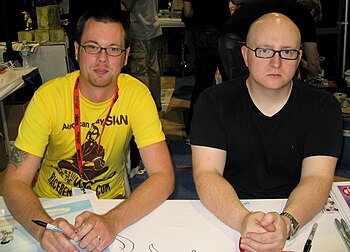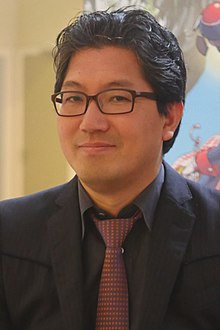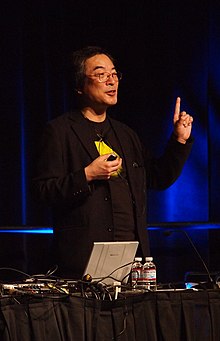The Video Games Portal

A video game or computer game is an electronic game that involves interaction with a user interface or input device (such as a joystick, controller, keyboard, or motion sensing device) to generate visual feedback from a display device, most commonly shown in a video format on a television set, computer monitor, flat-panel display or touchscreen on handheld devices, or a virtual reality headset. Most modern video games are audiovisual, with audio complement delivered through speakers or headphones, and sometimes also with other types of sensory feedback (e.g., haptic technology that provides tactile sensations). Some video games also allow microphone and webcam inputs for in-game chatting and livestreaming.
Video games are typically categorized according to their hardware platform, which traditionally includes arcade video games, console games, and computer (PC) games; the latter also encompasses LAN games, online games, and browser games. More recently, the video game industry has expanded onto mobile gaming through mobile devices (such as smartphones and tablet computers), virtual and augmented reality systems, and remote cloud gaming. Video games are also classified into a wide range of genres based on their style of gameplay and target audience. (Full article...)
Featured articles –
The game was conceived in 1985 by Ron Gilbert and Gary Winnick, who sought to tell a comedic story based on horror film and B-movie clichés. They mapped out the project as a paper-and-pencil game before coding commenced. While earlier adventure titles had relied on command lines, Gilbert disliked such systems, and he developed Maniac Mansion's simpler point-and-click interface as a replacement. To speed up production, he created a game engine called SCUMM, which was used in many later LucasArts titles. After its release, Maniac Mansion was ported to several platforms. A port for the Nintendo Entertainment System had to be reworked heavily, in response to Nintendo of America’s concerns that the game was inappropriate for children.
Maniac Mansion was critically acclaimed: reviewers lauded its graphics, cutscenes, animation, and humor. Writer Orson Scott Card praised it as a step toward "computer games [becoming] a valid storytelling art". It influenced numerous graphic adventure titles, and its point-and-click interface became a standard feature in the genre. The game's success solidified Lucasfilm as a serious rival to adventure game studios such as Sierra On-Line. In 1990, Maniac Mansion was adapted into a three-season television series of the same name, written by Eugene Levy and starring Joe Flaherty. A sequel to the game, Day of the Tentacle, was released in 1993. (Full article...)
Taking place 1500 years after the events of Blood Omen, Soul Reaver chronicles the journey of the vampire-turned-wraith Raziel, lieutenant to the vampire lord Kain. Raziel is killed by Kain, but is revived by The Elder God to become his "soul reaver" and to exact revenge. Raziel shares this title with Kain's sword, the Soul Reaver, which he acquires during the game.
Crystal Dynamics began development of the game in 1997, but a deteriorating relationship with Silicon Knights, who had developed Blood Omen, created legal problems. This and other delays forced material originally planned for Soul Reaver to be instead released with later games of the series. Soul Reaver was generally well received by critics and praised for its intriguing gothic story and high-quality graphics. However, the game was criticized for simple and repetitive gameplay and an unsatisfying climax. By 2001, the game sold 1.5 million copies worldwide. (Full article...)
The game was directed by Fumito Ueda and developed at Sony Computer Entertainment's International Production Studio 1, also known as Team Ico, the same development team responsible for the acclaimed PlayStation 2 title Ico, to which the game is considered a spiritual successor. Сonceived as an online multiplayer game titled NICO directly after Ico's completion, Shadow of the Colossus underwent a lengthy production cycle during which it was redeveloped as a single-player title. The team sought to create an outstanding interactive experience by including a distinct visual design, an unorthodox gameplay template, and non-player characters with sophisticated artificial intelligence such as the colossi and Wander's horse, Agro.
Cited as an influential title in the video game industry and one of the best video games ever made, Shadow of the Colossus is often regarded as an important example of video games as art due to its minimalist landscape designs, immersive gameplay, and emotional weight of the player character's journey. It received wide critical acclaim by the media and was met with strong sales compared to Ico, due in part to a larger marketing campaign. The game won several awards for its audio, design, and overall quality. A remastered version for the PlayStation 3 was released alongside Ico as The Ico & Shadow of the Colossus Collection in September 2011, developed by Bluepoint Games, who later produced a high definition remake of the game for the PlayStation 4 in 2018. (Full article...)
Namco Limited was a Japanese multinational video game and entertainment company, headquartered in Ōta, Tokyo. It held several international branches, including Namco America in Santa Clara, California, Namco Europe in London, Namco Taiwan in Kaohsiung, and Shanghai Namco in mainland China.
Namco was founded by Masaya Nakamura on June 1, 1955, as Nakamura Seisakusho, beginning as an operator of coin-operated amusement rides. After reorganizing to Nakamura Seisakusho Co., Ltd. in 1959, a partnership with Walt Disney Productions provided the company with the resources to expand its operations. In the 1960s, it manufactured electro-mechanical arcade games such as the 1965 hit Periscope. The name comes from Nakamura Manufacturing Company. It entered the video game industry after acquiring the struggling Japanese division of Atari in 1974, distributing games such as Breakout in Japan. The company renamed itself Namco in 1977 and published Gee Bee, its first original video game, a year later. Among Namco's first major hits was the fixed shooter Galaxian in 1979. It was followed by Pac-Man in 1980. Namco prospered during the golden age of arcade video games in the early 1980s, releasing popular titles such as Galaga, Xevious, and Pole Position.
Namco entered the home console market in 1984 with conversions of its arcade games for the MSX and the Nintendo Family Computer. Its American division majority-acquired Atari Games in 1985, before selling a portion of it in 1987 following disagreements between the two companies. Arguments over licensing contracts with Nintendo led Namco to produce games for competing platforms, such as the Sega Genesis, TurboGrafx-16, and PlayStation. (Full article...)
Betrayal is the only installment in the series to originally be released on a non-PlayStation platform and presented as a two-dimensional (2D) side-scrolling game. Despite the limitations of the mobile platform, in comparison to its home console counterparts, it retains the action-oriented approach of its predecessors, with the same combination of combo-based combat, platforming, and puzzle game elements. Although God of War is primarily a home console series, Betrayal was praised for its fidelity to the series in terms of gameplay, art style, and graphics: "the real deal third game in the killer franchise". It received awards for "Wireless Game of the Month" (June 2007) and "Best Platform Game" (wireless) of 2007. (Full article...)
Psygnosis hired design studio The Designers Republic to create a simple color scheme and design for in-game menus and race courses, to create what a Psygnosis staff member called "a believable future". The game is one of the few PlayStation titles to run in 16:9 widescreen and high-resolution mode, offering crisper graphics and visuals. Wipeout 3's soundtrack is composed of electronica tracks selected by DJ Sasha and features contributions by Orbital and The Chemical Brothers. The game was re-released in Europe as Wipeout 3: Special Edition in August 2000, which contained additional tracks and content.
The game was positively received on release: critics lauded the graphics, music, and minimalist design elements. The high level of difficulty and lack of new content, courses, or game features were seen as the game's primary faults. Wipeout 3 was the last title in the series to appear on the PlayStation; the next entry, Wipeout Fusion, was released exclusively for the PlayStation 2 platform in 2002. (Full article...)
Did you know... -
- ... that the video game JFK Reloaded recreates the assassination of John F. Kennedy from the perspective of the killer?
- ... that the graffiti artists hired for the video game Skitchin' were interviewed at a train station because they were too young to drive?
- ... that the 1979 video game Superman was one of the first console games with a pause feature?
- ... that the developer of The Stillness of the Wind was inspired to make the video game after fantasizing with his girlfriend about raising goats instead of living in London?
- ... that before Sarah Elmaleh voiced the player character in the video game Anthem, developed by BioWare, she voiced characters in a mod of an earlier BioWare game?
- ... that development on the video game Expeditions: Rome was not affected by lockdowns from the COVID-19 pandemic because the developer was already split between Copenhagen and Istanbul?
- ... that the video game Fursan al-Aqsa received an update that allows players to reenact the October 7 attacks on Israel?
- ... that the leak of the upcoming Grand Theft Auto game was described as one of the biggest leaks in video game history?
- ... that the 2005 video game Bokura no Kazoku was inspired in part by the birth of its creator's first child?
- ... that a cheat code in the video game Spyro: Year of the Dragon grants access to a near-complete copy of Crash Bash?
- ... that fighting video game Panza Kick Boxing was endorsed by a French kickboxing champion who also supplied technical advice?
- ... that Elena from the video game series Street Fighter uses a capoeira fighting style, for which the development team used travel videos as reference material as they had no experience with the style?
Selected biography –
Selected image -

- April 16, 2024 – 2023–2024 video game industry layoffs
- American video game company Take-Two Interactive lays off 5% of its workforce. (Reuters)
- April 10, 2024 – 2023–2024 video game industry layoffs
- American video game company Epic Games announces that it will lay-off around 870 employees, roughly one-sixth of its workforce, due to slower growth than expected. (CBC via Yahoo! News)
- December 22, 2023 –
- China passes a series of regulations aimed at limiting video game microtransactions. The new rules include banning rewards for logging on for multiple consecutive days and banning rewards for players if they spend money in a game for the first time. (Reuters)
Topics
Categories
Things you can do
In other Wikimedia projects
The following Wikimedia Foundation sister projects provide more on this subject:
- Commons
Free media repository - Wikibooks
Free textbooks and manuals - Wikidata
Free knowledge base - Wikinews
Free-content news - Wikiquote
Collection of quotations - Wikisource
Free-content library - Wikiversity
Free learning tools - Wiktionary
Dictionary and thesaurus














































